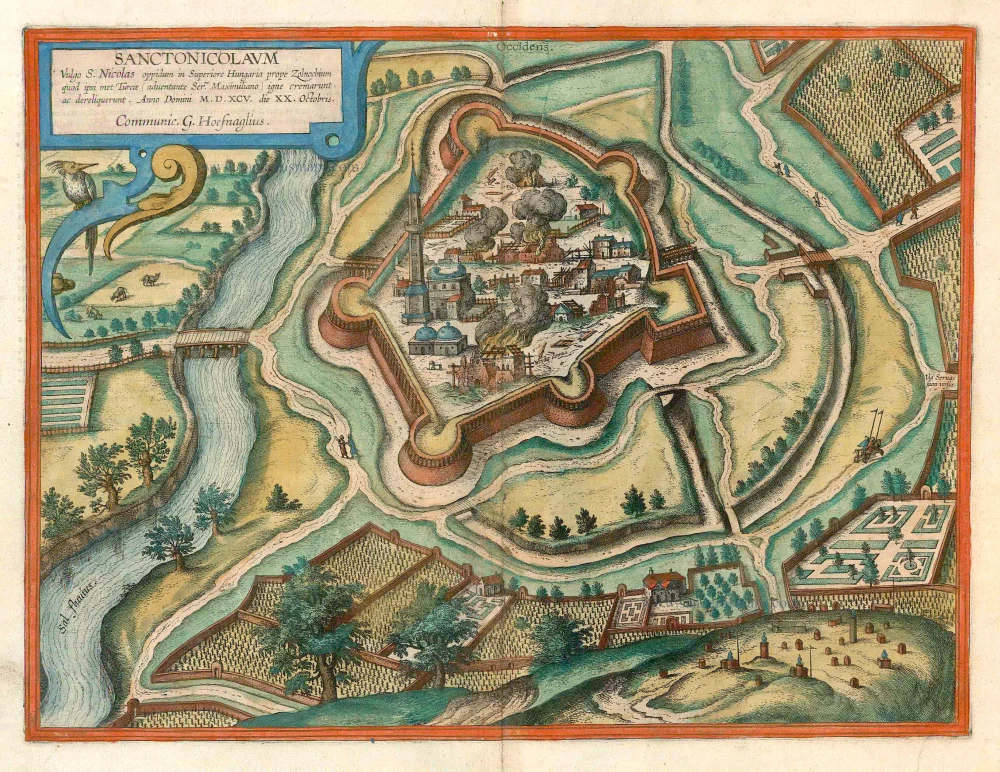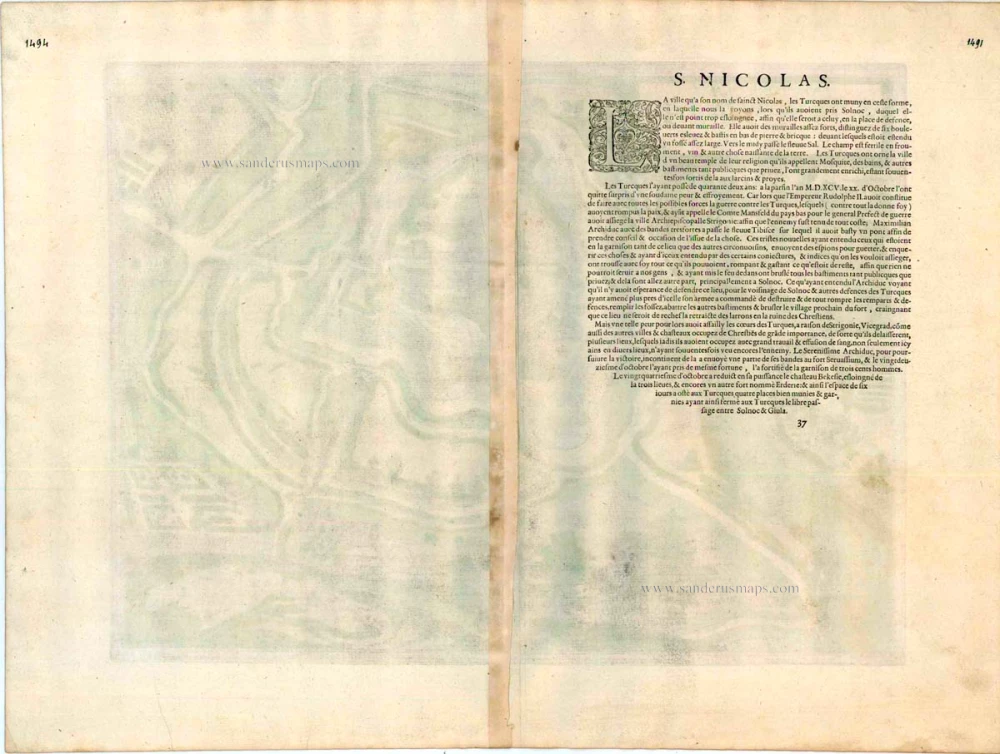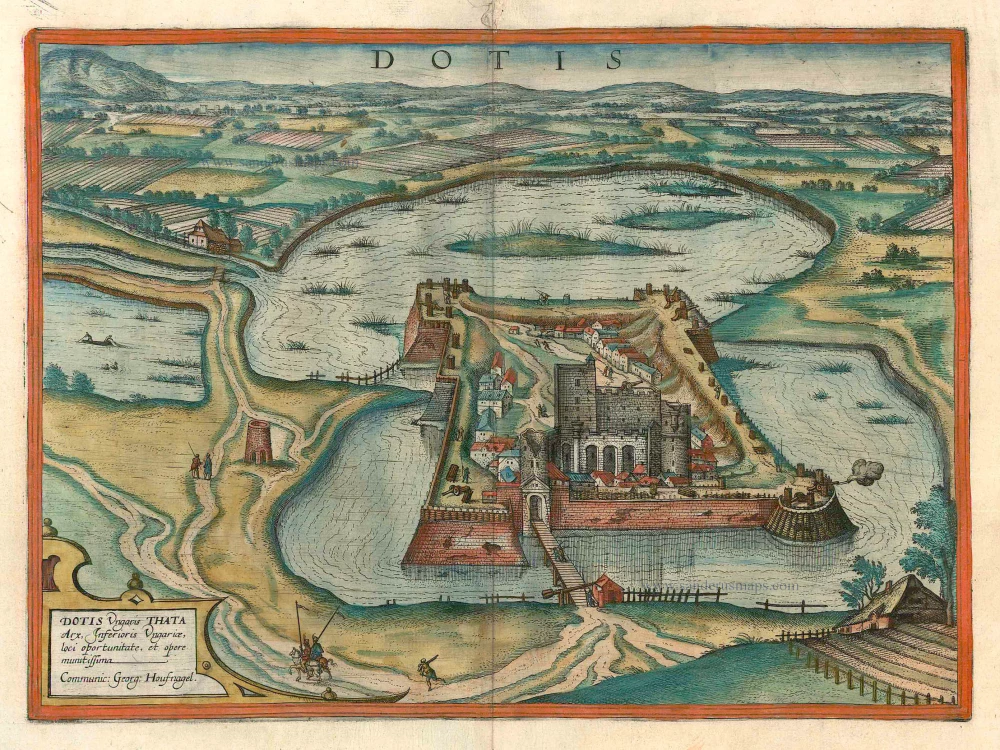Törökszentmiklos by Braun G. & Hogenberg F. c. 1625
CARTOUCHE: Sanctonicolaum, in the vernacular Törökszentmiklós, a town in Upper Hungary near Zolnochium, was set on fire and abandoned by the Turks on the arrival of Emperor Maximilian. 20 October 1595. Procured by Georg Hoefnagel.
COMMENTARY BY BRAUN (on verso): "The soil of the surrounding farmland is very fertile for vines, grain and root crops. For this reason, the Turks would have liked to stay longer, as is clear from the splendid mosque, the baths and other fine houses they built here, particularly as it was also a real robbers' den and well-situated for good booty. [...] After the Christians had captured Esztergom, Weissengrad and other castles and fortresses, the Turks became so stricken with fear that they abandoned not only this but also other fortresses and fled without good cause."
The Turkish fortress is shown from a birds-eye perspective looking towards the east. It lies to the east of Szolnok and is shown when many buildings are going up in flames or have already been destroyed. The cartouche text tells us that this event occurred on 20 October 1595, with the Turks having set their fortress on fire during their retreat when Emperor Rudolf II (erroneously called Maximilian in the cartouche) was approaching with his troops. A few buildings have been preserved, including the minaret of the partially destroyed mosque and, in front of it, the Turkish bath with its two domes. An Ottoman cemetery can be seen in the bottom right-hand corner. (Taschen)
Braun G. & Hogenberg F. and the Civitates Orbis Terrarum.
The Civitates Orbis Terrarum, also known as the 'Braun & Hogenberg', is a six-volume town atlas and the most excellent book of town views and plans ever published: 363 engravings, sometimes beautifully coloured. It was one of the best-selling works in the last quarter of the 16th century. Georg Braun, a skilled writer, wrote the text accompanying the plans and views on the verso. Many plates were engraved after the original drawings of a professional artist, Joris Hoefnagel (1542-1600). The first volume was published in Latin in 1572 and the sixth in 1617. Frans Hogenberg, a talented engraver, created the tables for volumes I through IV, and Simon van den Neuwel made those for volumes V and VI. Other contributors were cartographers Daniel Freese and Heinrich Rantzau, who provided valuable geographical information. Works by Jacob van Deventer, Sebastian Münster, and Johannes Stumpf were also used as references. Translations appeared in German and French, making the atlas accessible to a wider audience.
Since its original publication of volume 1 in 1572, the Civitates Orbis Terrarum has left an indelible mark on the history of cartography. The first volume was followed by seven more editions in 1575, 1577, 1582, 1588, 1593, 1599, and 1612. Vol.2, initially released in 1575, saw subsequent editions in 1597 and 1612. The subsequent volumes, each a treasure trove of historical insights, graced the world in 1581, 1588, 1593, 1599, and 1606. The German translation of the first volume, a testament to its widespread appeal, debuted in 1574, followed by the French edition in 1575.
Several printers were involved: Theodor Graminaeus, Heinrich von Aich, Gottfried von Kempen, Johannis Sinniger, Bertram Buchholtz, and Peter von Brachel, all of whom worked in Cologne.
Georg Braun (1541-1622)
Georg Braun, the author of the text accompanying the plans and views in the Civitates Orbis Terrarum, was born in Cologne in 1541. After his studies in Cologne, he entered the Jesuit Order as a novice, indicating his commitment to learning and intellectual pursuits. In 1561, he obtained his bachelor's degree; in 1562, he received his Magister Artium, further demonstrating his academic achievements. Although he left the Jesuit Order, he continued his studies in theology, gaining a licentiate in theology. His theological background likely influenced the content and tone of the text in the Civitates Orbis Terrarum, adding a unique perspective to the work.
Frans Hogenberg (1535-1590)
Frans Hogenberg was a Flemish and German painter, engraver, and mapmaker. He was born in Mechelen as the son of Nicolaas Hogenberg.
By the end of the 1560s, Frans Hogenberg was employed upon Abraham Ortelius's Theatrum Orbis Terrarum, published in 1570; he is named an engraver of numerous maps. In 1568, he was banned from Antwerp by the Duke of Alva and travelled to London, where he stayed a few years before emigrating to Cologne. He immediately embarked on his two most important works, the Civitates, published in 1572 and the Geschichtsblätter, which appeared in several series from 1569 until about 1587.
Thanks to large-scale projects like the Geschichtsblätter and the Civitates, Hogenberg's social circumstances improved with each passing year. He died as a wealthy man in Cologne in 1590.
Sanctonicolaum vulgo S. Nicolas Oppidum in Superiore Hungaria prope Zolnochium quod ipsi met Turcae ...
Item Number: 16453 Authenticity Guarantee
Category: Antique maps > Europe > Central Europe
Törökszentmiklos by Braun G. & Hogenberg F.
Title: Sanctonicolaum vulgo S. Nicolas Oppidum in Superiore Hungaria prope Zolnochium quod ipsi met Turcae ...
Date of the first edition: 1617.
Date of this map: c. 1625.
Copper engraving, printed on paper.
Image size: 330 x 450mm (12.99 x 17.72 inches).
Sheet size: 410 x 540mm (16.14 x 21.26 inches).
Verso: French text.
Condition: Contemporary coloured, excellent.
Condition Rating: A+.
From: Théatre des Principales Villes de tout l'Univers Vol. VI. c. 1625. (Van der Krogt 4, 41:3.6)
CARTOUCHE: Sanctonicolaum, in the vernacular Törökszentmiklós, a town in Upper Hungary near Zolnochium, was set on fire and abandoned by the Turks on the arrival of Emperor Maximilian. 20 October 1595. Procured by Georg Hoefnagel.
COMMENTARY BY BRAUN (on verso): "The soil of the surrounding farmland is very fertile for vines, grain and root crops. For this reason, the Turks would have liked to stay longer, as is clear from the splendid mosque, the baths and other fine houses they built here, particularly as it was also a real robbers' den and well-situated for good booty. [...] After the Christians had captured Esztergom, Weissengrad and other castles and fortresses, the Turks became so stricken with fear that they abandoned not only this but also other fortresses and fled without good cause."
The Turkish fortress is shown from a birds-eye perspective looking towards the east. It lies to the east of Szolnok and is shown when many buildings are going up in flames or have already been destroyed. The cartouche text tells us that this event occurred on 20 October 1595, with the Turks having set their fortress on fire during their retreat when Emperor Rudolf II (erroneously called Maximilian in the cartouche) was approaching with his troops. A few buildings have been preserved, including the minaret of the partially destroyed mosque and, in front of it, the Turkish bath with its two domes. An Ottoman cemetery can be seen in the bottom right-hand corner. (Taschen)
Braun G. & Hogenberg F. and the Civitates Orbis Terrarum.
The Civitates Orbis Terrarum, also known as the 'Braun & Hogenberg', is a six-volume town atlas and the most excellent book of town views and plans ever published: 363 engravings, sometimes beautifully coloured. It was one of the best-selling works in the last quarter of the 16th century. Georg Braun, a skilled writer, wrote the text accompanying the plans and views on the verso. Many plates were engraved after the original drawings of a professional artist, Joris Hoefnagel (1542-1600). The first volume was published in Latin in 1572 and the sixth in 1617. Frans Hogenberg, a talented engraver, created the tables for volumes I through IV, and Simon van den Neuwel made those for volumes V and VI. Other contributors were cartographers Daniel Freese and Heinrich Rantzau, who provided valuable geographical information. Works by Jacob van Deventer, Sebastian Münster, and Johannes Stumpf were also used as references. Translations appeared in German and French, making the atlas accessible to a wider audience.
Since its original publication of volume 1 in 1572, the Civitates Orbis Terrarum has left an indelible mark on the history of cartography. The first volume was followed by seven more editions in 1575, 1577, 1582, 1588, 1593, 1599, and 1612. Vol.2, initially released in 1575, saw subsequent editions in 1597 and 1612. The subsequent volumes, each a treasure trove of historical insights, graced the world in 1581, 1588, 1593, 1599, and 1606. The German translation of the first volume, a testament to its widespread appeal, debuted in 1574, followed by the French edition in 1575.
Several printers were involved: Theodor Graminaeus, Heinrich von Aich, Gottfried von Kempen, Johannis Sinniger, Bertram Buchholtz, and Peter von Brachel, all of whom worked in Cologne.
Georg Braun (1541-1622)
Georg Braun, the author of the text accompanying the plans and views in the Civitates Orbis Terrarum, was born in Cologne in 1541. After his studies in Cologne, he entered the Jesuit Order as a novice, indicating his commitment to learning and intellectual pursuits. In 1561, he obtained his bachelor's degree; in 1562, he received his Magister Artium, further demonstrating his academic achievements. Although he left the Jesuit Order, he continued his studies in theology, gaining a licentiate in theology. His theological background likely influenced the content and tone of the text in the Civitates Orbis Terrarum, adding a unique perspective to the work.
Frans Hogenberg (1535-1590)
Frans Hogenberg was a Flemish and German painter, engraver, and mapmaker. He was born in Mechelen as the son of Nicolaas Hogenberg.
By the end of the 1560s, Frans Hogenberg was employed upon Abraham Ortelius's Theatrum Orbis Terrarum, published in 1570; he is named an engraver of numerous maps. In 1568, he was banned from Antwerp by the Duke of Alva and travelled to London, where he stayed a few years before emigrating to Cologne. He immediately embarked on his two most important works, the Civitates, published in 1572 and the Geschichtsblätter, which appeared in several series from 1569 until about 1587.
Thanks to large-scale projects like the Geschichtsblätter and the Civitates, Hogenberg's social circumstances improved with each passing year. He died as a wealthy man in Cologne in 1590.





